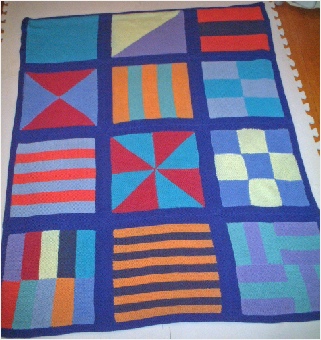

Click to read general information about afghans



Buy a pattern
for this afghan
on the order form
 Buy now
Buy now

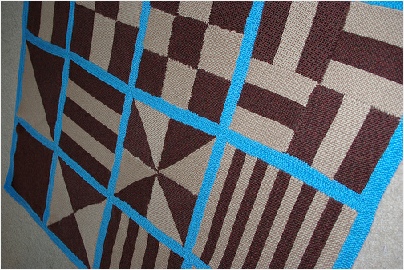
This photo was sent us by Grace.
This is what she wrote on her web site :
Equal Parts – Done!
I’ve always thought that there are two kinds of knitters in the world. Process knitters love to knit, no matter what. All they need to hear is the clicking of the needles. It doesn’t matter if they’ve knitted the same pattern a dozen times before. They just love to knit. Project knitters like to see completed projects. They see a pattern, and the mind immediately goes to “Yes, I want THAT project!” They can’t be bothered to knit the same pattern again unless they truly want a duplicate (or near duplicate) product.
I’ve known for a long time that I’m a product knitter. My love of stuffies and the way I feel when I finish their faces and see them come alive told me that. However, I’ve never been so sure of it as I am now.
When I saw “Equal Parts”, all I could see was that it looked like the perfect project for the recipient. I didn’t bother to consider little things like how long it would take to complete the project, how enjoyable the knitting would be, or anything else for that matter.
However, as the months dragged on, I started doing the mental work that I should have done before I started.
Each square averages 66 stitches by 66 rows. That’s over 4000 stitches per square.
Each square is bordered by 5 rows. Add another 1,300 stitches or so per square.
There are twelve squares. Multiply 4300 times 12. That’s over 50,000 stitches.
The twelve squares are bound together and then bordered by another 5 rows. Add on another few thousand stitches.
Sigh. And to make it even happier, it’s almost all garter stitch. And mostly brown on brown.
Although projects like this are not the most exciting, the big pay-
Whoo hoo! It’s done! It’s done!
While the actual experience of knitting it wasn’t all that pleasant (and was, at some times, downright mind-
I replied to Grace:
You already know I love your blanket.
I’m not sure whether this will make you feel better or worse about your achievement but you have actually knitted twice as many stitches as you think you have. The squares are 66 stitches by 66 ridges, which means 132 rows!
Even though the figures are wrong, I just love your calculations. It’s part of what our teaching is all about.

EQUAL PARTS
The design is to be found on the walls of many UK schools as a poster, published by Tarquin Publications.
The afghan came first. It shows fractions from 1 -
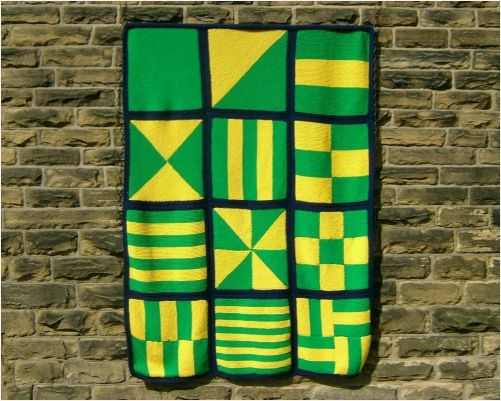

Scroll down for more information about
Equal Parts

RELATED DESIGNS
HALF-
HALF-

CONSTRUCTION INFORMATION
The twelve squares are made in various ways. Some are in a single piece; others need to be stitched.

KNITTING INFORMATION
The pattern gives instructions for making the afghan in DK or Aran weight yarns. Other yarns can be used though the finished afghan, may be bigger, or smaller than the original.
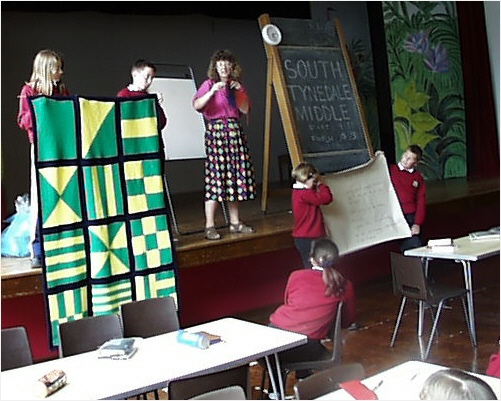
Equal Parts on loan to South Tynedale Middle School for their mathematical knitting project.
The pupils went on to produce their own afghan.

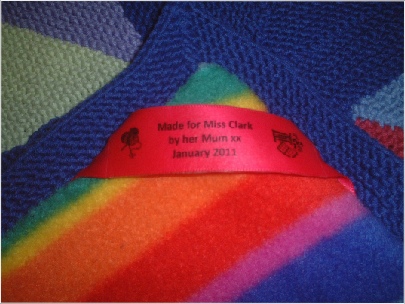
I also made the label by reverse printing the words onto t-
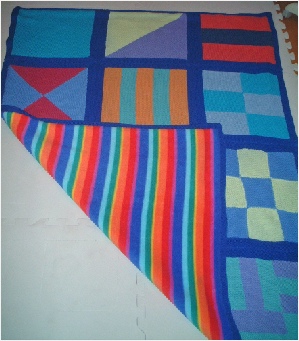
This afghan was made by Rachel Clark.
She said:
My daughter works at North Beckton Primary, which is a mainstream primary school in Newham, East London, with places for children with severe physical disabilities or complex medical conditions.
I wanted to use bright colours, and also a washable yarn, as she uses it on her chair in the classroom and so I chose Sublime Soya Cotton DK and knitted it on quite small needles to keep the fabric quite tight, but as it is so large and heavy I realised that I would need to back it or it would lose it's shape quite quickly. I purchased some very bright multi-
